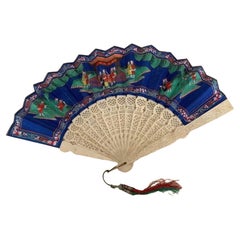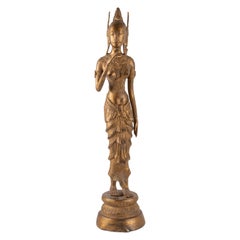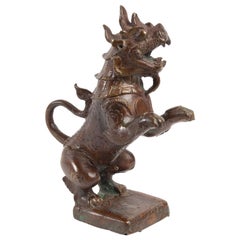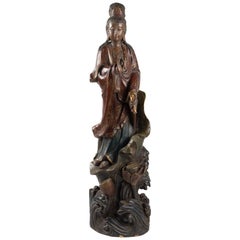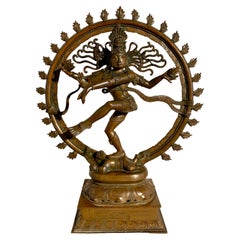Galerie Martynoff Paris Sculptures and Carvings
to
4
4
2
2
2
1
1
2
1
1
1
1
4
2
2
4
4
4
Beautiful Chinese fan of Canton of the 19th Century
Located in Saint-Ouen, FR
Beautiful Chinese fan of Canton of the 19th century in Bone, Paper and Silk.
Dimensions: H: 49cm, W: 28cm, D: 2cm.
Category
Antique 19th Century Chinese Chinese Export Sculptures and Carvings
Materials
Bone, Silk
Indonesian Goddess in Gilded Metal Holding a Lotus Flower, 1920-1940
Located in Saint-Ouen, FR
Indonesian goddess in gilded metal holding a lotus flower, 1920-1940.
Measures: H 61cm, W 15cm, W 15cm.
Category
Vintage 1920s Asian Chinese Export Metalwork
Materials
Metal
Bronze Sculpture, Late 19th Century, Asia
Located in Saint-Ouen, FR
Bronze sculpture, late 19th century, Asia
Measures: H 19cm, W 15cm, W 8cm.
Category
Antique 1880s Asian Chinese Export Animal Sculptures
Materials
Bronze
Guanyin in Carved Wood and Polichrome, China, Early 20th Century, Asian Art
Located in Saint-Ouen, FR
Guanyin in carved wood and polichrome, China, early 20th century, Asian art
Measures: H 56cm, W 16cm, W 15cm.
Category
Vintage 1910s Chinese Chinese Export Figurative Sculptures
Materials
Wood
Related Items
18th Century Hand-Carved Jichi Wood Guanyin Figure
Located in New York, NY
This beautiful sculpture realized in China in the 18th century depicts Guanyin, a Bodhisattva associated with compassion. The female form holds a pot in her hands. She appears draped...
Category
Antique 18th Century Chinese Qing Figurative Sculptures
Materials
Hardwood
Large Bronze Dancing Shiva, Nataraja, 19th/20th Century, South India
Located in Austin, TX
A heavy and well cast South Indian bronze figure of Shiva Nataraja, or Shiva as Lord of the Dance, in the Chola style, late 19th or early 20th century, India.
Shiva is portrayed here in his form as Nataraja, the Lord of the Dance. An iconic and powerful image, Shiva is portrayed engaged in his dance of creation, protection, and destruction, bringing together all his aspects into one sublime form.
Shiva dances ecstatically, facing the viewer with his body twisted, his long locks of hair streaming out around him, his four arms in action, with one leg raised, the other stomping on the dwarf demon Apasmara, who represents spiritual ignorance.
In one hand he holds a damaru, or ritual drum...
Category
Antique Early 1900s Indian Sculptures and Carvings
Materials
Bronze
Densatil Gilt Bronze Caryatid Figure, Tibet, 15th Century
Located in Austin, TX
A heavy and solidly cast, richly gilt, bronze caryatid figure from Densatil Monastery, Central Tibet, early 15th century or earlier.
Cast in the form of two four armed figures standing back to back in tribhanga (thrice bent position) on a lotus platform, this piece would originally have served as a pillar for a larger seated deity...
Category
Antique 15th Century and Earlier Tibetan Tibetan Sculptures and Carvings
Materials
Bronze
Pair of Chinese Bronze Deity Figures, 20th Century
Located in Belmont, MA
Pair of Chinese bronze figures of deities standing on dragons. The two sculptures were made in the 20th century. They represent the Tao gods Lu Xing and Fu Xin...
Category
Vintage 1980s Chinese Chinese Export Sculptures and Carvings
Materials
Bronze
$1,000 Sale Price / set
47% Off
H 21 in W 8.5 in D 12.5 in
19th Century Painted Wooden Tibetan Bowl
Located in Atlanta, GA
A beautiful late 19th century paint bowl with a lid that was once used for storing the famous Tibetan barley flour (Tsampa). These bowls were used by the Buddhist mountain people of ...
Category
Antique Late 19th Century Tibetan Sculptures and Carvings
Materials
Wood, Lacquer, Paint
Large Asian Bronze Foo Dogs
Located in Atlanta, GA
Pair of Large Asian Bronze Foo Dogs or Kylin Dragon, probably Chinese, circa 1950s or earlier. They retain their warm original patina. These were purch...
Category
Vintage 1950s Chinese Chinese Export Animal Sculptures
Materials
Bronze
Chinese Carved Boxwood Figure of Guanyin, Mid-Qing Dynasty
Located in Austin, TX
A sublime Chinese carved boxwood figure of the Bodhisattva of Compassion, Avalokiteshvara, called Guanyin in Chinese, mid-Qing dynasty.
The an...
Category
Antique Late 18th Century Chinese Qing Sculptures and Carvings
Materials
Boxwood
19th Century Sculpture of Guan Yu '关羽'
Located in Dublin 8, IE
19th Century sculpture of Guan Yu (??), a guardian deity.
Guan Yu (d. A.D. 219), a warrior of the late Han dynasty (206 B.C.–A.D. 220) renowned for his valo...
Category
Antique 19th Century Irish Chinese Export Figurative Sculptures
Materials
Metal
Early 20th Century Antique Chinese Carved Stone Buddha Head Sculpture
Located in Pomona, CA
This magnificent Chinese Antique Carved Stone Buddha Head was handcrafted dated back to 1900s and shows very detailed hand carving works on it. You can see from the pictures that It ...
Category
Early 20th Century Chinese Chinese Export Sculptures and Carvings
Materials
Stone
$967 Sale Price
25% Off
H 16.5 in W 7.5 in D 8 in
Genryusai Seiya Japanese Meiji Man & Water Buffalo Sculpture on Stand
Located in Bishop's Stortford, Hertfordshire
An exceptional Japanese Meiji bronze sculpture of a man and water buffalo on a natural polished oak stand by renowned Japanese master craftsman Genryusai Seiya and dating from around 1880/90. The large bronze depicts an elderly man holding a pipe and tobacco pouch...
Category
Antique 1880s Japanese Anglo-Japanese Sculptures and Carvings
Materials
Bronze
$12,715 Sale Price
44% Off
H 13.78 in W 17.33 in D 5.52 in
Late 19th century Pair of Glazed Porcelain Foo Dogs
Located in Savannah, GA
Extraordinary pair of fine glazed porcelain Foo dogs came to us out of an estate here in Savannah, Georgia, belonging to an old general that long ago brought them from Thailand. Used...
Category
Antique 1890s Chinese Qing Sculptures and Carvings
Materials
Porcelain
Pair of Japanese Cast Bronze Figures of Niō, Meiji Period, Late 19th Century
Located in Austin, TX
A well cast pair of Japanese mixed metal okimono figures of Buddhist guardians, known as Nio or Dharmapala, protectors of Buddhist faith, Meiji Period, Japan.
The smiling bronze g...
Category
Antique Late 19th Century Japanese Meiji Sculptures and Carvings
Materials
Bronze
$1,750 / set
H 9 in W 4.5 in D 4 in
